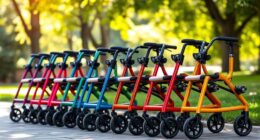Yes, caregivers typically undergo drug testing to guarantee they're fit to provide safe and reliable care for vulnerable clients. This testing is often mandated by employers as part of pre-employment checks. Common methods include urine and hair tests, which help detect recent drug use and provide a thorough evaluation of an individual's history. By confirming a drug-free status, caregivers can build trust with clients and their families. If you're curious about the testing process, there's more to explore.
Key Takeaways
- Yes, caregivers often undergo drug testing as part of pre-employment background checks mandated by many agencies and employers.
- Common drug testing methods for caregivers include urine tests, which detect recent use, and hair tests, which identify use over a longer period.
- Urine tests typically deliver results within two business days, while hair tests may take up to five days for processing.
- Drug testing enhances the quality of care by ensuring staff are drug-free, protecting vulnerable clients and providing peace of mind to families.
- Random drug testing may also be implemented to ensure ongoing compliance and safety in caregiving environments.
The Importance of Drug Testing for Caregivers

When you think about the safety of vulnerable clients, especially seniors, the importance of drug testing for caregivers becomes clear.
Drug screening is essential in ensuring that caregivers are fit to provide care. Many agencies and employers mandate pre-employment background checks that include caregiver drug tests to maintain a safe environment.
These tests typically use common and reliable types, like urine and hair tests, to detect recent drug use. By implementing such policies, employers can enhance the quality of care, knowing their staff is drug-free.
This process not only protects clients but also offers peace of mind to families, reinforcing trust in the caregiving relationship.
Ultimately, drug testing is a critical component of caregiver vetting that benefits everyone involved.
Common Drug Testing Methods Used

Caregiver safety and client well-being hinge on reliable drug testing methods. Two commonly used methods are urine sample tests and hair sample tests.
Urine tests can detect drug use from the past 72 hours and typically deliver results within two business days. If you're looking for a quicker option, on-site urine testing can provide results in just 30 minutes.
On the other hand, hair sample tests can detect drug use up to 90 days prior, requiring a minimum of 100 milligrams or 90-120 strands for analysis.
Both methods often utilize a standard 10-panel drug screening test to detect drugs like marijuana, cocaine, and opiates, ensuring a thorough evaluation of a caregiver's drug use history.
Comparison of Urine and Hair Drug Tests

While both urine and hair drug tests serve essential roles in screening caregivers, they differ considerably in their detection capabilities and processing times.
- Urine tests can detect drug use from the past 72 hours.
- Hair tests identify drug use up to 90 days prior.
- Urine tests yield results in about two business days, while hair tests can take up to five days.
Urine tests are effective at screening for substances like amphetamines, marijuana, cocaine, and opiates. In contrast, hair tests can also detect these drugs, along with additional substances depending on the testing panel.
To guarantee thorough results, combining both urine and hair tests is recommended, as each method highlights different aspects of drug use.
Understanding the Drug Testing Process

Understanding the drug testing process is essential for anyone involved in caregiving, as it directly impacts both employment opportunities and client safety.
Most caregivers must undergo pre-employment drug tests as part of the hiring process. Common methods include urine tests, which deliver results within two business days, and hair tests that can detect drug use for up to 90 days.
Typically, a standard 10-panel drug screen is used, testing for substances like marijuana, cocaine, opiates, and methamphetamines. Employers may also implement random drug testing to guarantee compliance with safety regulations.
Many opt for medical labs like LabCorp to conduct these tests, accommodating caregivers' needs during the testing process while maintaining a drug-free environment.
Addressing Barriers Faced by Caregiver Dependent Individuals

If you're a caregiver-dependent individual, you might encounter significant employment barriers during drug testing.
Many facilities don't provide the necessary accommodations for your needs, which can lead to stress and anxiety.
However, exploring solutions like outpatient labs can help guarantee a more accessible and supportive testing experience.
Employment Barriers Explained
Employment barriers for caregiver-dependent individuals can be intimidating, as societal attitudes often undermine their potential contributions to the workforce.
You might face:
- Discrimination that questions your effectiveness based on caregiving responsibilities.
- Accessibility issues that limit your engagement in the job market.
- Standard drug tests that lack necessary accommodations, adding stress to an already challenging process.
These barriers don't just hinder employment opportunities; they can also lead to emotional distress, as highlighted by personal stories like Reina Grosvalet's.
Advocating for better support, such as using medical labs for drug testing instead of third-party sites, can improve experiences for caregiver-dependent individuals. Rebuilding trust is essential in addressing these employment barriers and creating a more supportive environment.
Recognizing these issues is the first step toward fostering a more inclusive work environment.
Solutions for Accessibility Issues
Barriers faced by caregiver-dependent individuals can greatly impact their job prospects, particularly when it comes to drug testing.
To tackle accessibility issues, start by communicating with recruiters and employers about your need for caregiver assistance during drug tests. They may agree to conduct tests at medical labs, like LabCorp, known for accommodating caregivers. This approach can ease the process considerably.
Additionally, it's essential for employers to advocate for inclusive practices, ensuring medical labs understand the needs of caregiver-dependent individuals. Sharing your experiences can help raise awareness and promote change in employment settings, paving the way for more accessible drug testing protocols. Moreover, fostering collaboration between QA and development teams can lead to more effective solutions for accessibility challenges in the workplace.
Together, we can create a more inclusive environment for all job seekers.
Recommendations for Employers and Caregivers

To guarantee a safe and reliable caregiving environment, employers should implement clear drug testing policies that are communicated effectively to all potential hires. Pre-employment drug tests are essential for ensuring caregiver reliability.
Here are some recommendations for employers:
- Use medical labs that accommodate caregivers needing assistance.
- Clearly outline the types of drug tests administered, like urine or hair tests.
- Implement random drug testing to maintain accountability.
Employers must also advocate for inclusive practices, ensuring caregivers with disabilities receive necessary accommodations during the testing process.
Frequently Asked Questions
Do You Need to Pass a Drug Test to Be a Caregiver?
To be a caregiver, you'll likely need to pass a drug test. These tests help guarantee the safety of clients and maintain a drug-free workplace.
Most agencies require pre-employment screenings, and some even conduct random tests for current employees. Common testing methods include urine and hair samples, targeting substances like marijuana, opiates, and amphetamines.
Being prepared for these tests can increase your chances of securing a caregiver position and maintaining employment.
What Jobs Are Least Likely to Drug Test?
If you're looking for jobs that're least likely to require drug testing, consider creative fields like arts, design, and writing.
Many tech startups and remote positions also skip drug tests.
Retail and food service jobs vary, but often don't enforce strict testing.
Nonprofits and small businesses may avoid it due to budget constraints.
Administrative roles and certain customer service jobs typically have minimal safety risks, making drug testing less common in those areas.
Does Home Health Aide Drug Test?
If you think being a Home Health Aide is all sunshine and rainbows, think again!
Yes, Home Health Aides undergo drug tests, often as part of the pre-employment process. These tests typically involve a 10-panel urine test, checking for various substances.
You can usually expect results within two business days. Plus, employers might conduct random tests later on to guarantee safety, so staying clean is essential if you want to keep your job!
Do They Drug Test Healthcare Workers?
Yes, healthcare workers often undergo drug testing as part of their employment process. This usually includes a 10-panel drug screen that checks for various substances, ensuring a safe environment for patients.
Some organizations may perform random tests to maintain a drug-free workplace. While the results from urine tests typically come back within two business days, hair tests can take longer.
It's crucial to understand that testing protocols can vary by state and organization.
Conclusion
In summary, drug testing for caregivers is essential for ensuring safety and trust. Did you know that nearly 70% of people in recovery report feeling safer in environments with drug-tested staff? This statistic highlights the importance of maintaining a drug-free workplace, ultimately benefiting both caregivers and those they care for. By implementing regular testing, employers can foster a healthier, more secure environment for everyone involved. Let's prioritize safety and support in caregiving roles.









